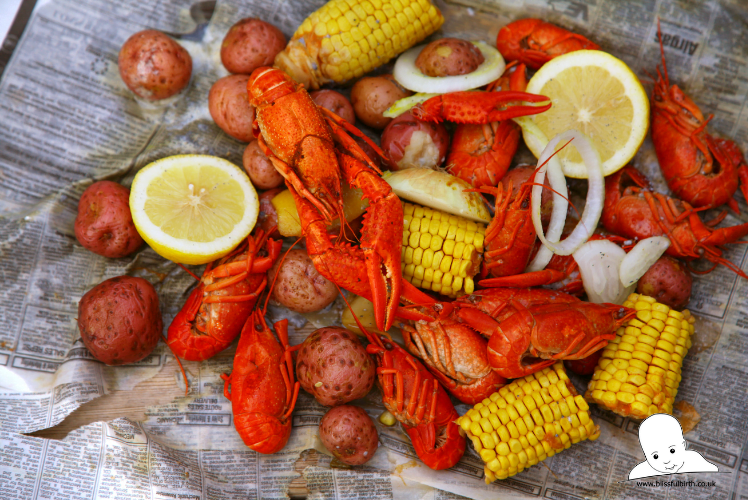Pregnancy is a transformative journey, filled with excitement, anticipation, and a myriad of questions. Among these questions is the safety of consuming certain foods, including seafood like crawfish.
This article aims to provide a detailed exploration of the safety and benefits of consuming crawfish during pregnancy.

Table of Contents
Quick Answer
Yes – you can eat crawfish while pregnant. However, it’s imperative to ensure the crawfish is fully cooked, sourced from clean and unpolluted waters, and consumed in moderation.
As with all dietary choices during pregnancy, it’s always best to prioritize safety and consult with healthcare professionals for personalized advice.
The Nutritional Benefits of Crawfish
Protein for Growth and Repair
Crawfish offers a substantial amount of lean protein, which is vital during pregnancy.
Protein acts as the building block of our body, supporting the growth of the baby and the upkeep of maternal tissues.
Consuming adequate protein ensures muscle growth, repair, and overall fetal development.
Omega-3 Fatty Acids for Brain and Eye Development
These essential fats found in crawfish are crucial for the development of the baby’s brain and eyes.
A good dose of omega-3s promotes cognitive and visual development, ensuring the baby’s neurological health.
Essential Vitamins and Minerals
Crawfish is a treasure trove of vital vitamins and minerals. It’s rich in vitamin B12, which is essential for nerve function and DNA synthesis.
The iron content aids in preventing anemia, while selenium acts as a powerful antioxidant.
Additionally, the iodine in crawfish supports thyroid function, ensuring a healthy metabolism for both mother and baby.
A Low-Fat Nutrient Powerhouse
While being nutrient-dense, crawfish is also low in fat. This makes it an excellent choice for those mindful of their calorie intake, ensuring that expecting mothers can enjoy its benefits without excessive calorie consumption.
Crawfish and Mercury Levels
Low Mercury Content
Crawfish boasts a low mercury level, placing it among the safer seafood options during pregnancy. This low mercury content allows expecting mothers to enjoy crawfish without the looming concern of mercury exposure, which can be detrimental to the developing nervous system of the fetus.
The Importance of Sourcing
While crawfish inherently has low mercury levels, its source plays a significant role in its safety. Always opt for crawfish sourced from clean, unpolluted waters. Imported crawfish or those from polluted habitats might carry a higher
FDA & Pregnancy Assoc Recommendations
Seafood Consumption Guidelines
Both the FDA and the American Pregnancy Association have set forth guidelines for seafood consumption during pregnancy. They emphasize the importance of moderation and informed choices.
The general recommendation is to limit seafood intake to 8-12 ounces per week. This ensures that expecting mothers can enjoy the benefits of seafood, including crawfish, without the risk of overexposure to potential contaminants.
Prioritizing Low-Mercury Seafood
While seafood offers numerous health benefits, it’s essential to prioritize options with low mercury content.
The FDA provides a list of seafood categorized by their mercury levels, and crawfish is among the safer choices.
By adhering to these guidelines, pregnant women can ensure the safety of their dietary choices for both themselves and their developing babies.
Potential Risks and Precautions
The Dangers of Raw or Undercooked Crawfish
Consuming raw or undercooked crawfish poses a risk of bacterial or parasitic infections, such as Listeria. These infections can lead to severe health complications for both the mother and the fetus.
It’s imperative to ensure that crawfish is fully cooked before consumption, eliminating any potential pathogens.
The Significance of Clean Sourcing
The source of the crawfish plays a pivotal role in its safety. Crawfish from polluted or contaminated waters can carry harmful toxins or pathogens.
Always ensure that the crawfish is sourced from clean, unpolluted waters, and if possible, opt for trusted suppliers or certified farms.
Handling and Storage Precautions
Proper handling and storage of crawfish are essential to maintain its freshness and safety. Avoid cross-contamination by using separate utensils for raw and cooked seafood.
Store crawfish at the right temperature and consume it within the recommended timeframe to prevent bacterial growth.
Cooking and Handling Crawfish Safely
Proper Cooking Techniques
Ensuring that crawfish is cooked thoroughly is the first line of defense against potential infections. The flesh should appear pearly and opaque, indicating that it’s fully cooked.
Boiling is a popular method, and it’s essential to ensure that the crawfish is immersed in boiling water for an adequate duration to kill any pathogens.
Preventing Cross-Contamination
Cross-contamination can occur when raw seafood comes in contact with other foods, surfaces, or utensils.
To prevent this, always use separate cutting boards and utensils for raw and cooked crawfish.
After handling raw crawfish, wash your hands thoroughly with soap and water to eliminate any residual bacteria or parasites.
Storing Crawfish Correctly
Proper storage is crucial to maintain the freshness of crawfish. If you’re not cooking them immediately, store live crawfish in a cool, moist environment, preferably in a refrigerator.
Once cooked, store leftovers in airtight containers and consume within two days to ensure safety and freshness.
Alternative Safe Seafood Options
Diversifying Seafood Intake
While crawfish is a delicious and nutritious option, it’s beneficial to diversify seafood intake during pregnancy. This not only provides a variety of nutrients but also minimizes the risk associated with consuming any single type of seafood.
Safe Seafood Choices
Salmon, sardines, and shrimp are excellent alternatives to crawfish. They are not only flavorful but also low in mercury and rich in essential nutrients.
These options provide omega-3 fatty acids, lean protein, and a host of vitamins and minerals that support both maternal health and fetal development.
Checking for Marine Advisories
Before consuming any seafood, especially if it’s caught locally, it’s advisable to check for marine advisories.
These advisories provide information about potential contamination in specific water bodies, helping you make informed choices.
Symptoms of Unsafe Crawfish Consumption
Recognizing Food Poisoning Symptoms
After consuming crawfish, it’s essential to be vigilant about potential symptoms of food poisoning.
Common signs include nausea, vomiting, diarrhea, abdominal pain, and fever. These symptoms can manifest within hours or even days after consumption, depending on the type of pathogen involved.
Immediate Actions to Take
If you suspect food poisoning after eating crawfish, it’s crucial to seek medical attention promptly. Staying hydrated is vital, as diarrhea and vomiting can lead to dehydration.
Avoid self-medication and consult with a healthcare professional for appropriate treatment and guidance.
The Importance of Reporting
If you believe the crawfish you consumed was contaminated, consider reporting it to local health departments. This can help authorities track the source of contamination and prevent further cases in the community.
Conclusion
Pregnancy is a time of heightened responsibility, with every dietary choice impacting both the mother and the developing baby.
While crawfish offers numerous health benefits, it’s essential to ensure it’s fully cooked, sourced from clean waters, and consumed in moderation. When handled properly, expecting mothers can enjoy this delicacy without compromising safety.
Always remember that individual circumstances can vary. While general guidelines provide a foundation, it’s always best to consult with healthcare professionals for personalized advice.




